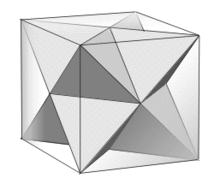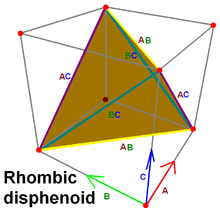- Demihypercube
-
Not to be confused with Hemicube (geometry).
 Alternation of the n-cube yields one of two n-demicubes, as in this 3-dimensional illustration of the two tetrahedra that arise as the 3-demicubes of the 3-cube.
Alternation of the n-cube yields one of two n-demicubes, as in this 3-dimensional illustration of the two tetrahedra that arise as the 3-demicubes of the 3-cube.
In geometry, demihypercubes (also called n-demicubes, n-hemicubes, and half measure polytopes) are a class of n-polytopes constructed from alternation of an n-hypercube, labeled as hγn for being half of the hypercube family, γn. Half of the vertices are deleted and new facets are formed. The 2n facets become 2n (n-1)-demicubes and 2n (n-1)-simplex facets are formed in place of the deleted vertices.
They have been named with a demi- prefix to each hypercube name: demicube, demitesseract, etc. The demicube is identical to the regular tetrahedron, and the demitesseract is identical to the regular 16-cell. The demipenteract is considered semiregular for having only regular facets. Higher forms don't have all regular facets but are all uniform polytopes.
Contents
Discovery
Thorold Gosset described the demipenteract in his 1900 publication listing all of the regular and semiregular figures in n-dimensions above 3. He called it a 5-ic semi-regular. It also exists within the semiregular k21 polytope family.
The demihypercubes can be represented by extended Schläfli symbols of the form h{4,3,...,3} as half the vertices of {4,3,...,3}. The vertex figures of demihypercubes are rectified n-simplexes.
Constructions
They are represented by Coxeter-Dynkin diagrams of three constructive forms:




 ...
... (As an alternated orthotope) s{2n-1}
(As an alternated orthotope) s{2n-1}


 ...
...
 (As an alternated hypercube) h{4,3n-1}
(As an alternated hypercube) h{4,3n-1}


 ...
...
 . (As a demihypercube) {31,n-3,1}
. (As a demihypercube) {31,n-3,1}
H.S.M. Coxeter also labeled the third bifurcating diagrams as 1k1 representing the lengths of the 3 branches and lead by the ringed branch.
An n-demicube, n greater than 2, has n*(n-1)/2 edges meeting at each vertex. The graphs below show less edges at each vertex due to overlapping edges in the symmetry projection.
n 1k1 Petrie
polygonSchläfli symbol Coxeter-Dynkin diagrams
Cn family
Dn familyElements Facets:
Demihypercubes &
SimplexesVertex figure Vertices Edges Faces Cells 4-faces 5-faces 6-faces 7-faces 8-faces 9-faces 2 1-1,1 Demisquare
(digon)

s{21}
h{4}
{31,-1,1}








2 2
2 edges-- 3 101 demicube
(tetrahedron)


s{22}
h{4,3}
{31,0,1}












4 6 4 (6 digons)
4 trianglesTriangle
(Rectified triangle)4 111 demitesseract
(16-cell)


s{23}
h{4,3,3}
{31,1,1}


















8 24 32 16 8 demicubes
(tetrahedra)
8 tetrahedraOctahedron
(Rectified tetrahedron)5 121 demipenteract


s{24}
h{4,33}{31,2,1}
























16 80 160 120 26 10 16-cells
16 5-cellsRectified 5-cell 6 131 demihexeract


s{25}
h{4,34}{31,3,1}






























32 240 640 640 252 44 12 demipenteracts
32 5-simplicesRectified hexateron 7 141 demihepteract


s{26}
h{4,35}{31,4,1}




































64 672 2240 2800 1624 532 78 14 demihexeracts
64 6-simplicesRectified 6-simplex 8 151 demiocteract


s{27}
h{4,36}{31,5,1}










































128 1792 7168 10752 8288 4032 1136 144 16 demihepteracts
128 7-simplicesRectified 7-simplex 9 161 demienneract


s{28}
h{4,37}{31,6,1}
















































256 4608 21504 37632 36288 23520 9888 2448 274 18 demiocteracts
256 8-simplicesRectified 8-simplex 10 171 demidekeract


s{29}
h{4,38}{31,7,1}






















































512 11520 61440 122880 142464 115584 64800 24000 5300 532 20 demienneracts
512 9-simplicesRectified 9-simplex ... n 1n-3,1 n-demicube s{2n-1}
h{4,3n-2}{31,n-3,1}













 ...
...












 ...
...











 ...
...

2n-1 n (n-1)-demicubes
2n (n-1)-simplicesRectified (n-1)-simplex In general, a demicube's elements can be determined from the original n-cube: (With Cn,m = mth-face count in n-cube = 2n-m*n!/(m!*(n-m)!))
- Vertices: Dn,0 = 1/2 * Cn,0 = 2n-1 (Half the n-cube vertices remain)
- Edges: Dn,1 = Cn,2 = 1/2 n(n-1)2n-2 (All original edges lost, each square faces create a new edge)
- Faces: Dn,2 = 4 * Cn,3 = n(n-1)(n-2)2n-3 (All original faces lost, each cube creates 4 new triangular faces)
- Cells: Dn,3 = Cn,3 + 2n-4Cn,4 (tetrahedra from original cells plus new ones)
- Hypercells: Dn,4 = Cn,4 + 2n-5Cn,5 (16-cells and 5-cells respectively)
- ...
- [For m=3...n-1]: Dn,m = Cn,m + 2n-1-mCn,m+1 (m-demicubes and m-simplexes respectively)
- ...
- Facets: Dn,n-1 = n + 2n ((n-1)-demicubes and (n-1)-simplices respectively)
Symmetry group
The symmetry group of the demihypercube is the Coxeter group Dn, [3n-3,1,1] has order 2n − 1n!, and is an index 2 subgroup of the hyperoctahedral group (which is the Coxeter group BCn [4,3n-1]).
Orthotopic constructions
 The rhombic disphenoid inside of a cuboid
The rhombic disphenoid inside of a cuboid
Constructions as alternated orthotopes have the same topology, but can be stretched with different lengths in n-axes of symmetry.
The rhombic disphenoid is the three-dimensional example as alternated cuboid. It has three sets of edge lengths, and scalene triangle faces.
See also
- Hypercube honeycomb
- Semiregular E-polytope
References
- T. Gosset: On the Regular and Semi-Regular Figures in Space of n Dimensions, Messenger of Mathematics, Macmillan, 1900
- John H. Conway, Heidi Burgiel, Chaim Goodman-Strass, The Symmetries of Things 2008, ISBN 978-1-56881-220-5 (Chapter 26. pp. 409: Hemicubes: 1n1)
External links
- Olshevsky, George, Half measure polytope at Glossary for Hyperspace.
Dimension Dimensional spaces One · Two · Three · Four · Five · Six · Seven · Eight · n-dimensions · Spacetime · Projective space · Hyperplane
Polytopes and Shapes Concepts and mathematics Cartesian coordinates · Linear algebra · Geometric algebra · Conformal geometry · Reflection · Rotation · Plane of rotation · Space · Fractal dimension · MultiverseCategory Fundamental convex regular and uniform polytopes in dimensions 2–10 Family An BCn Dn E6 / E7 / E8 / F4 / G2 Hn Regular polygon Triangle Square Hexagon Pentagon Uniform polyhedron Tetrahedron Octahedron • Cube Demicube Dodecahedron • Icosahedron Uniform polychoron 5-cell 16-cell • Tesseract Demitesseract 24-cell 120-cell • 600-cell Uniform 5-polytope 5-simplex 5-orthoplex • 5-cube 5-demicube Uniform 6-polytope 6-simplex 6-orthoplex • 6-cube 6-demicube 122 • 221 Uniform 7-polytope 7-simplex 7-orthoplex • 7-cube 7-demicube 132 • 231 • 321 Uniform 8-polytope 8-simplex 8-orthoplex • 8-cube 8-demicube 142 • 241 • 421 Uniform 9-polytope 9-simplex 9-orthoplex • 9-cube 9-demicube Uniform 10-polytope 10-simplex 10-orthoplex • 10-cube 10-demicube n-polytopes n-simplex n-orthoplex • n-cube n-demicube 1k2 • 2k1 • k21 pentagonal polytope Topics: Polytope families • Regular polytope • List of regular polytopes Categories:- Polytopes
Wikimedia Foundation. 2010.
